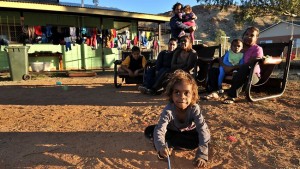Home » Commentary » Opinion » White adoptions won’t create new Stolen Generation
· The Daily Telegraph

 THERE has been predictable whingeing that Federal Children’s Minister David Gillespie says indigenous kids should be adopted by white families because he is a ‘racist critic of indigenous parenting’.
THERE has been predictable whingeing that Federal Children’s Minister David Gillespie says indigenous kids should be adopted by white families because he is a ‘racist critic of indigenous parenting’.
But Gillespie is right: the only way to properly protect abused indigenous children — and stop them being recycled back into harm — is to allow adoption by non-indigenous families.
Tragically, the ever-growing number of indigenous children removed from their families reflects worsening dysfunction in some indigenous communities.
At the start of the century, 4000 indigenous children nationwide — two per cent of the total indigenous child population — had been taken into ‘out of home care’. In 2017, almost 18,000 indigenous kids were in care; or six per cent of all indigenous children.
The Aboriginal Child Placement Principle (ACPP), embedded in legislation in all states and territories, obliges child protection authorities to try to place indigenous children into ‘kinship care’ with relatives or local community members.
The good intention is to ensure these children continue to have connections with traditional culture, and avoid the negative impact that separation from families had on the identity of the Stolen Generations.
But in practice, compliance with the ACCP can lead to ‘culture’ trumping child welfare. The social problems in rural and remote indigenous communities — combined with high birth rates, high-adult mortality, and high adult to child ratios — have created a shortage of safe kinship carers.
Hence only around 50 per cent of removed indigenous children are kinship placed. But this does not mean that all kinship placements are safe and suitable.
In the name of maintaining culture, some indigenous children are placed back in harm’s way in kinship placements that do not meet basic standards — and into which non-indigenous children would not be placed.
For example, the two-year old girl allegedly raped in a notorious town camp outside Tennant Creek was living in the ‘culturally-appropriate’ kinship care of relatives who were supposedly looking after her at the time.
In response, many politicians and indigenous spokespeople have insisted that culture should never be allowed to take precedence over children’s wellbeing.
But putting this sound principle into effect won’t be possible unless there are sufficient safe and permanent homes available for all the indigenous children who need to be rescued.
Breaking the taboo around adoption by ‘white’ families would stop indigenous children being removed from the frying pan of family dysfunction only to end up exposed to the fire of wider community dysfunction.
Nevertheless, some sections of the indigenous lobby are campaigning hard to reduce the number of child removals and increase compliance with the ACPP.
Indigenous adoption would not create the ‘new Stolen Generation’, these critics falsely claim it will.
The rhetoric about ‘stealing’ children again ignores that we are not talking about removing children based on their race, but based on proven abuse and neglect and demonstrable family and community dysfunction.
Moreover, it ignores the way modern adoption practices balance children’s cultural and welfare needs.
When overseas children are adopted, we don’t forget about their heritage. Rather, we maintain and nurture their cultural identity by visits back to their birth country, by enrolment at a school with children from the same background, and by engagement and participation in local ethnic community activities.
As part of overseas adoption, adoptive parents are counselled about the need to ensure children have continued contact with birth parents and extended families back home; and are also expected to state how they will ensure contact with the child’s birth culture.
There is no reason the same model — which ensures that all the children’s needs, including cultural needs, are paramount — cannot apply to indigenous adoption.
‘Cultural support plans’ are already a standard part of child protection practice, to connect indigenous children to their culture when they are unable to be placed with kin.
Hence there is no need to obsess about ‘matching’ — ensuring indigenous kids are adopted only by indigenous families — given how this obsession has led to black children waiting longer for adoption, or not being adopted at all, in the UK.
Under a ‘colourblind’ approach to adoption, indigenous organisations could also be funded to run post-adoption cultural support and education programs for children and their new families.
This would not only safely reconcile culture and identity with child welfare — and avoid any question of a repeat of the Stolen Generations, it would also end Australia’s ‘apartheid’ child protection regime that treats indigenous children differently based on race.
Jeremy Sammut is a Senior Research Fellow at The Centre for Independent Studies and author of The Madness of Australian Child Protection.
White adoptions won’t create new Stolen Generation